
views
X
Research source
It is a way to increase self-esteem. The process of striving for our goals can also help us develop into better people. So, whether your dream is to earn a million dollars, become an artist, or be a world-class athlete, don't wait. Start working toward your goal today.
Setting Goals

Decide what you want. Your first step is to determine what it is you want to achieve. This can be a big change or small one, but taking some time to think about what you hope to achieve is an important first step to success. For example, is your goal to be a happier person? To learn to play an instrument? To get good at a sport? To be healthier? All of these are valid goals. It's up to you to decide what you want.
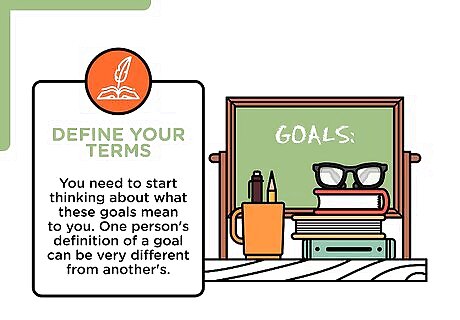
Define your terms. Once you have a general sense of what you want, you need to start thinking about what these goals mean to you. One person's definition of a goal can be very different from another's. For example, if your goal is to be happier, you need to think about what happiness means to you. What does a happy life look like? What types of things will make you happy? This applies to less overreaching goals as well. If your goal is to learn to play guitar, what does that mean exactly to you? Will you be satisfied with knowing a few chords so people can sing along with you at parties? Or are you striving to be a classical concert guitarist? These are very different definitions of knowing how to play the guitar.
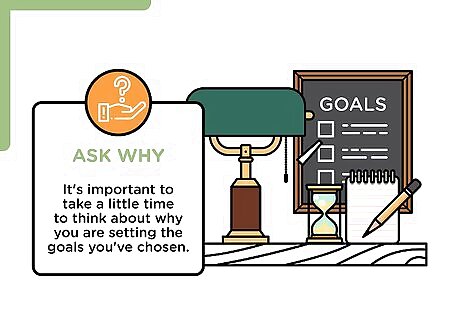
Ask why. It's important to take a little time to think about why you are setting the goals you've chosen. If you think about your motivations, you may find that you end up wanting to revise your goals. For example, imagine your goal is to learn to play the guitar. You stop and think about why, and you realize that it's because you think people who play the guitar are popular at school. This doesn't really suggest dedication to the guitar. It might be a good reason to stop and ask yourself if there's another, easier way to get what you really want, which is more social than musical.
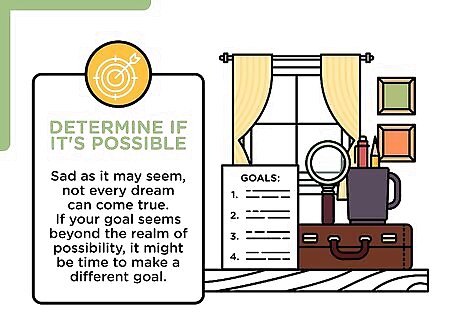
Determine if it's possible. Last but not least, you need to decide if your goal is realistic. Sad as it may seem, not every dream can come true. If your goal seems beyond the realm of possibility, it might be time to make a different goal. Imagine you decide it is your dream to be the world's greatest basketball player. That's a challenging goal for anyone to achieve, but it might be possible for some people. But, if you're only 5 feet (1.5 m) tall, this goal is probably beyond your reach. This sets you up for failure and discouragement. You can still have fun playing basketball with your friends. But, if you're looking to be the best at a sport, you should probably focus on one where height isn't so important.
Making a Plan

Brainstorm in writing. Once you've set a general goal, you need to start getting more specific and making a plan to reach it. A great first step is to do some free-writing. Get some paper and write down some thoughts about the following topics: Your ideal future Qualities you admire in others Things that could be done better Things you want to learn more about Habits you want to improve. This step is meant to help you fantasize and imagine many possibilities. After a few of these possibilities are out on paper, you can determine which ones are most important to you.
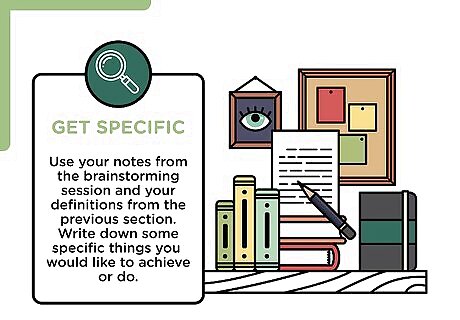
Get specific. Once you've thought about some goals and brainstormed a bit, its time to start getting more specific. Use your notes from the brainstorming session and your definitions from the previous section. Write down some specific things you would like to achieve or do. A vague goal like, “I want to play better, so I will do my best,” is not as effective as a goal like “I want to be able to play my favorite song in six months." Poorly defined end goals or vague “do-your-best” goals are not as effective as specific goals. Move beyond general goals like "I want to become rich" and focus on specific achievements that will get results. Instead of "I want to become rich," your goal could be "I want to master investing in the stock market." Instead of "I want to play the guitar," your goal could be something like "I want to play lead guitar in a rock band." It's a good idea to do some more writing here, trying to describe your goals in as much detail as possible.
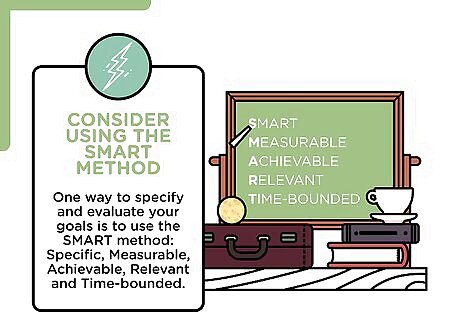
Consider using the SMART method. One way to specify and evaluate your goals is to use the SMART method. This is an approach to goal setting in which you refine your goals by assessing whether they are: Specific Measurable Achievable Relevant and Time-bounded
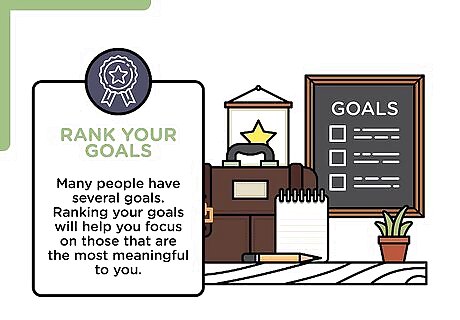
Rank your goals. Many people have several goals. In fact, in your free-writing, you may have discovered that you yourself are already hoping to achieve more than one goal. If this is the case, it's a good idea to try to rank them in order of importance. Ranking your goals will help you focus on those that are the most meaningful to you. For example, you might want to earn a PhD in astrophysics, learn to play classical guitar, read the complete works of Tolstoy, and run a marathon. Trying to do all of these things at once is probably not realistic. Deciding which goals are most important can help you plan for the long and short term. Part of this process is assessing your level of commitment to each goal. A difficult or long-term goal that you aren't highly committed to is one you are unlikely to achieve. If you only sort of want a PhD in astrophysics, you probably shouldn't make that a priority in life.
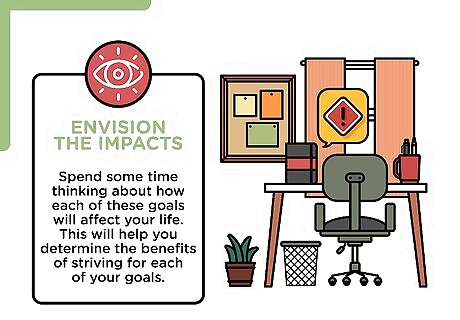
Envision the impacts. Spend some time thinking about how each of these goals will affect your life. This will help you determine the benefits of striving for each of your goals. Thinking in these terms will also help you visualize the process of striving for these goals. This can help boost your motivation.

Create subgoals. Most goals are more achievable if broken down into smaller tasks. These smaller tasks are subgoals—little goals that add up to the main goal you hope to achieve. For example, if you want to learn to play guitar, your first sub-goal might be to get a guitar. Your next might be to sign up for lessons. Next, you will want to learn the most basic chords and scales, and so on. Creating a schedule for these subgoals can help you stay focused and keep you on track. In the example above, you might aim to have enough money to buy a guitar in three months. You might plan to sign up for lessons a week after that, learn the basic chords in another two months, and so forth.
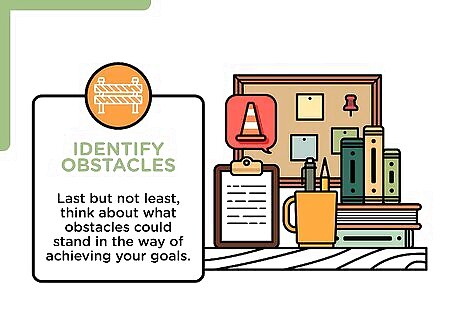
Identify obstacles. Last but not least, think about what obstacles could stand in the way of achieving your goals. Thinking about this in advance gives you a chance to come up with some ideas about how you will overcome those obstacles. For example, you might find that guitar lessons are more costly than you can afford right now. This could lead you to think about ways to get more money for lessons. Or, you might consider the possibility of teaching yourself using instructional books or videos.
Following Through
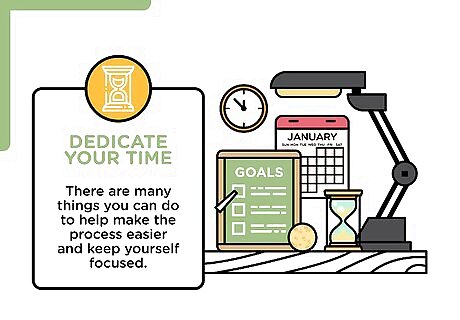
Dedicate your time. There are many things you can do to help make the process easier and keep yourself focused. At the end of the day though, most goals are achieved by putting a lot of time and hard work into making them a reality. Think about how long you expect it to take to achieve your goal, and when you want it to be completed. For example, imagine you expect you'll need 40 hours of work to master the basics of playing guitar and you want learn it in a month. You'll need to spend a little over an hour on this every day. There's no way to get around putting in the time. If you are truly committed to your goal, it is what you must do.

Make it a routine. One way to make putting in the time easier is to build your efforts into a daily routine. Schedule time to work on your goals into every day. For example, you might spend a half an hour from 6:30 practicing musical scales. You could spend another half an hour from 6:30 to 7 practicing chords. You could spend 15 minutes from 7:15 learning to play a specific song. If you stuck to this every day (or even every other day), you could learn the basics of playing any instrument very quickly!
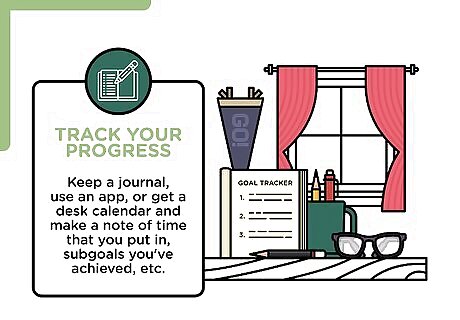
Track your progress. Once you start working toward your goal, keep track of your progress. Keep a journal, use an app, or get a desk calendar and make a note of time that you put in, subgoals you've achieved, etc. Tracking your progress can help you stay motivated by highlighting your successes. It can also help keep you accountable for sticking to your routine. Keeping a journal in which you write about the process daily is also a good way to reduce stress you might feel about achieving your goals.
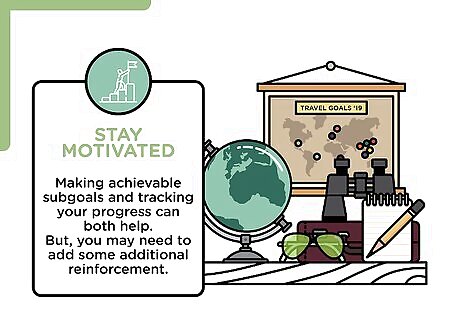
Stay motivated. One of the hardest parts of following through on a goal, especially in the long term, is staying motivated. Making achievable subgoals and tracking your progress can both help. But, you may need to add some additional reinforcement. Reinforcement means that you create consequences for your actions. There are two types of reinforcement. Positive reinforcement means adding something to your life. For example, you might treat yourself to a celebratory dessert for achieving a subgoal. Negative reinforcement is when something is taken away. If that something is unwanted, that can be a reward. For example, you might allow yourself to skip a chore one week as a reward for reaching a subgoal. This chore is "removed" from your life that week. Reinforcement is more effective in keeping up your motivation than punishment. Depriving yourself of things or otherwise punishing yourself for failure can work in small doses. But, stick to rewards instead when possible.




















Comments
0 comment